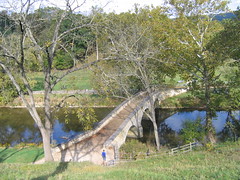 |
| Just a few fleeting moments left to see this place... |
A family of visitors walks up to the information desk and smiles at the interpreter. "We have 15 minutes," the father says, "What should we do?"
The interpreter replies with a curt smile: "Sit down and cry."
It sounds like such a flippant remark, it must be imaginary. But it's not. I've seen this exact exchange take place a few times already in my career as an interpreter. I've stood behind an information desk while another interpreter spoke those exact words to a visitor. Unfortunately, once things like that are said they can't be unsaid.
What does it mean, though? A visitor has 15 minutes and wants to find out why this place is important. And you have told them, in essence, that they could never find meaning within your site in such a short time. You have said in a quick moment that there is the 'right' way to see a historic landscape and that that just can't possibly happen in 15 minutes. So, the interpreter says, just give up. Cry because you have no time to truly see this place.
But why can't someone have a meaningful visit to a Civil War landscape in just 15 minutes? What could you say to that visitor to offer them a quick opportunity to understand and feel this place?
Perhaps you could circle Burnside's Bridge on a park map, give them simple directions and tell that man to stand with his family, squint at the bridge and try to imagine hundreds of men charging across and being cut down by rebel bullets.
Or you could show them the quick way to drive into the Lower Town. You could tell them to park in front of the small brick armory fire engine house and imagine what might cause a man to fight and die for another man's freedom. And you could ask them to imagine what they might kill for.
Or you could tell them to head into the museum exhibit and stare at the uniforms and guns hanging there in the cases. Tell them to imagine the sweaty arms that went in those sleeves, the greasy and nervous hands that gripped those rifle barrels. Tell them to look into the dioramas of Jackson's flank attack that have been here since the '60s and try to see the little clay figures moving, see the history come to life.
Or you could tell them to just wander the battlefield near the Angle in the stone wall where the Confederates poured into the Union lines and find a monument, any monument that catches their eye. You could tell them to read it. Tell them to touch it. Tell them they might want to take a family picture in front of it. Then maybe they could find it again when they come back.
There is no 'right' way to visit a special place. There is not a right itinerary or a wrong amount of time to budget for finding meaning in a place. There is only the amount of time a visitor has chosen to spend. It is never an interpreter's job to denigrate them or chastise them with snide comments like, "sit down and cry." It is our job to help them find meaning in these places, no matter how long they have chosen to be our guests.

No comments:
Post a Comment